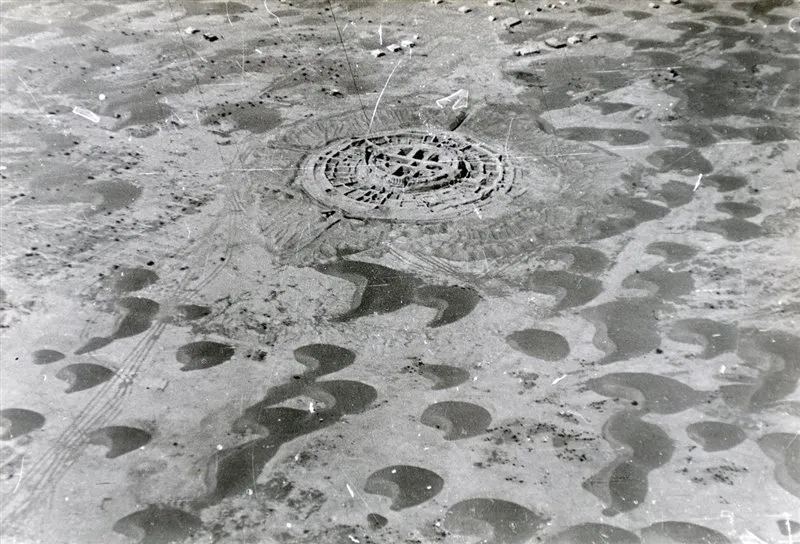Koi Krylgan Kala: A Fortress Offering Glimpses into Khwarezmian Astronomy, Cult, and Demise.
In 1938, the Soviet Academy of Sciences organized a large-scale expedition called the Khwarezmian Archaeological and Ethnographic Expedition , led by archaeologist and ethnographer Sergey Pavlovitch Tolstov, which aimed to investigate the remote region of Khwarezmian, an area stretching from the north of so-called Greater Iran (present-day Uzbekistan) to the eastern shores of the Caspian Sea, on the edge of the Kyzyl Kum Desert.

The Khwarez region had already gained independence from the Achaemenid Persian Empire when Alexander the Great conquered it in the 4th century BC. The area was considered a barren desert by Greek and Roman historians, who, following this conquest, described the Macedonian ruler as “a king of nomads ruling over an empty wilderness.” But millennia later, the Soviet expedition discovered that this claim was not entirely accurate. In fact, many scholars define Khwarez as a group of states located east of the Aral Sea and surrounded by the nomadic tribes of Central Asia. In other words, the region was abundantly populated.
Thus, when the Russian expeditionaries were camped near the ruins of Teshik Qala, an imposing fortress from the 7th and 8th centuries AD, they observed a distant silhouette “sunk into the sea of sand.” When they went to inspect it, they saw that it was a monumental circular building built between the 4th and 3rd centuries BC. The citadel stood in the exact center of a circular defensive fortification 87 meters in diameter, seven meters thick, and reinforced with nine towers , one of which was arranged as an entrance with a walled courtyard in front of it. Between the central structure, possibly an elite cemetery with a temple and a sanctuary dedicated to the dynastic cult, and the perimeter wall, there were vestiges of some residential and industrial buildings surrounded by a moat 15 meters wide and 3 meters deep. Archaeologists named this place Koi Krylgan Kala.
The citadel was at the exact center of a circular defensive fortification measuring 87 meters in diameter, seven meters thick, and with nine towers.

Reconstruction of the Koi Krylgan Kala fortress. Photo: CC (User1712)
The Koi Krylgan Kala complex is located next to the small town of Taza-Kel’timinar, which is currently part of the autonomous republic of Karakalpakstan, which, along with the twelve provinces and the city of Tashkent (the capital of Uzbekistan), makes up the present-day Republic of Uzbekistan. Although its true purpose remains unknown today, archaeological excavations have shown that the site had been destroyed by fire and then looted. Furthermore, it is possible that the lower floor housed some type of astronomical observatory from which to observe the movement of certain stars and perhaps the solar and lunar cycles. In fact, it is known that the Khwarezmians were very familiar with eclipses, which they knew how to predict (such as the one that occurred on February 29, 357 BC), and they had a very precise calendar to establish the cycle of the seasons, something vital for agricultural production.
Excavation of Koi Krylgan Kala began in the 1950s, and there archaeologists found numerous pottery remains, rhytons (vessels for drinking and making libations), jars, and plates decorated with reliefs depicting human heads, animals, griffins (a mythological animal that is half eagle and half lion), and warriors. Archaeologists also found numerous terracotta figures of deities (most notably Anahita, worshipped as the goddess of the waters and associated with fertility), human heads, horses, a monkey, and a griffin, which in this case had the body of a horse.
Koi Krylgan Kala began to be excavated in depth in the 1950s, and there archaeologists found numerous remains of pottery, rhytons, jars, and decorated plates.

Aerial view of Koi Krylgan Kala, near the town of Turtkul in the Republic of Karakalpakstan.Photo: PDMale figure found at Koi Krilgan Kala. Hermitage Museum, St. Petersburg.Photo: CC GNU Free Documentation License (Velero)
The mural paintings that decorated one of the walls of the central building at Koi Krylgan Kala have also provided a wealth of information about the site and the territory he dominated. In fact, researchers have concluded that the land where the complex was built must have been a very fertile wine-growing region supplied with water by a significant network of canals, since the mural depicts a bearded man holding a bunch of grapes and a jug of wine, as well as a female figure pouring wine into an amphora.

And what was the fate of Koi Krylgan Kala, a place that by all accounts seemed very prosperous? Apparently, this site was destroyed during the migrations and invasions of the Saka (a nomadic people of the steppes) that occurred in the region. However, there is evidence that shows that after its destruction, Koi Krylgan Kala was reoccupied and was continuously inhabited until the 4th century AD , when it was finally abandoned. Today, the enclosure can be visited, although both erosion and the use of the bricks used to build the outer enclosure by the inhabitants of neighboring villages to build their own houses seriously endanger its survival.






